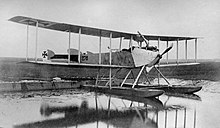Gotha WD.7
| WD.7 and WD.8 | |
|---|---|

| |
| Role | torpedo-bomber trainer and reconnaissance |
| National origin | Germany |
| Manufacturer | Gotha |
| First flight | December 1915 |
| Primary user | Imperial German Navy |
| Number built | 8 x WD.7 ; 1 x WD.8 |
The Gotha WD.7 (for Wasser Doppeldecker - "Water Biplane") was a reconnaissance floatplane developed in the German Empire during World War I.
Development[]

After the pusher WD.3 was not accepted by the Imperial German Navy, Gotha turned to a new layout that would keep the aircraft's nose free for forward-firing weapons. The WD.7 therefore, was a conventional biplane with twin engines mounted tractor-fashion on the leading edge of the lower wing. Eight examples were built for use as trainers for torpedo bombing. During 1917, two of these aircraft were used for testing a 37 mm (1.46 in) autocannon built by DWM.
The same airframe was used to create the WD.8 reconnaissance floatplane, substituting the twin wing-mounted engines with a single Maybach Mb.IVa in the nose.
Variants[]
- WD.7
- twin-engine torpedo bomber trainer floatplane, powered by two 120 hp (89 kW) Mercedes D.II.[1]
- WD.8
- single-engine reconnaissance floatplane, powered by a 240 hp (180 kW) Maybach Mb.IV.[1]
Specifications (WD.7)[]

Data from German Aircraft of the First World War[1]
General characteristics
- Crew: 3
- Length: 11.3 m (37 ft 1 in)
- WD.8: 11.2 m (37 ft)
- Wingspan: 16 m (52 ft 6 in)
- Height: 3.585 m (11 ft 9 in)
- Wing area: 55.5 m2 (597 sq ft)
- WD.8: 59 m2 (640 sq ft)
- Empty weight: 1,440 kg (3,175 lb)
- WD.8: 1,250 kg (2,760 lb)
- Gross weight: 1,970 kg (4,343 lb)
- WD.8: 1,770 kg (3,900 lb)
- Powerplant: 2 × Mercedes D.II 6-cylinder water-cooled in-line pistone engines, 89 kW (120 hp) each
Performance
- Maximum speed: 136 km/h (85 mph, 73 kn)
- WD.8: 130 km/h (81 mph; 70 kn)
- Service ceiling: 4,000 m (13,000 ft)
- WD.8: 4,500 m (14,800 ft)
Armament
- Guns: WD.8: 7.92 mm (0.312 in) Parabellum MG 14 machine gun in the rear cockpit
- Bombs: WD.7: 1 x training torpedo
References[]
| Wikimedia Commons has media related to |
- ^ a b c Gray, Peter; Thetford, Owen (1970). German Aircraft of the First World War (2nd ed.). London: Putnam. p. 400. ISBN 0-370-00103-6.
Further reading[]
- Taylor, Michael J. H. (1989). Jane's Encyclopedia of Aviation. London: Studio Editions. p. 428.
- World Aircraft Information Files. London: Bright Star Publishing. pp. File 895 Sheet 09.
- 1910s German military trainer aircraft
- Floatplanes
- Gotha aircraft
- Biplanes
- Twin piston-engined tractor aircraft
- Aircraft first flown in 1915